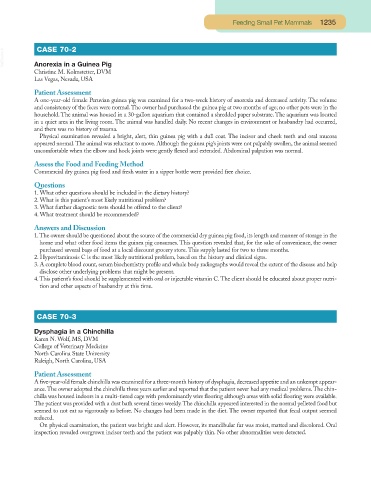Page 1185 - Small Animal Clinical Nutrition 5th Edition
P. 1185
Feeding Small Pet Mammals 1235
CASE 70-2
VetBooks.ir Anorexia in a Guinea Pig
Christine M. Kolmstetter, DVM
Las Vegas, Nevada, USA
Patient Assessment
A one-year-old female Peruvian guinea pig was examined for a two-week history of anorexia and decreased activity. The volume
and consistency of the feces were normal.The owner had purchased the guinea pig at two months of age; no other pets were in the
household. The animal was housed in a 30-gallon aquarium that contained a shredded paper substrate. The aquarium was located
in a quiet area in the living room. The animal was handled daily. No recent changes in environment or husbandry had occurred,
and there was no history of trauma.
Physical examination revealed a bright, alert, thin guinea pig with a dull coat. The incisor and cheek teeth and oral mucosa
appeared normal.The animal was reluctant to move. Although the guinea pig’s joints were not palpably swollen, the animal seemed
uncomfortable when the elbow and hock joints were gently flexed and extended. Abdominal palpation was normal.
Assess the Food and Feeding Method
Commercial dry guinea pig food and fresh water in a sipper bottle were provided free choice.
Questions
1. What other questions should be included in the dietary history?
2. What is this patient’s most likely nutritional problem?
3. What further diagnostic tests should be offered to the client?
4. What treatment should be recommended?
Answers and Discussion
1.The owner should be questioned about the source of the commercial dry guinea pig food, its length and manner of storage in the
home and what other food items the guinea pig consumes. This question revealed that, for the sake of convenience, the owner
purchased several bags of food at a local discount grocery store. This supply lasted for two to three months.
2. Hypovitaminosis C is the most likely nutritional problem, based on the history and clinical signs.
3. A complete blood count, serum biochemistry profile and whole body radiographs would reveal the extent of the disease and help
disclose other underlying problems that might be present.
4.This patient’s food should be supplemented with oral or injectable vitamin C.The client should be educated about proper nutri-
tion and other aspects of husbandry at this time.
CASE 70-3
Dysphagia in a Chinchilla
Karen N. Wolf, MS, DVM
College of Veterinary Medicine
North Carolina State University
Raleigh, North Carolina, USA
Patient Assessment
A five-year-old female chinchilla was examined for a three-month history of dysphagia, decreased appetite and an unkempt appear-
ance.The owner adopted the chinchilla three years earlier and reported that the patient never had any medical problems.The chin-
chilla was housed indoors in a multi-tiered cage with predominantly wire flooring although areas with solid flooring were available.
The patient was provided with a dust bath several times weekly.The chinchilla appeared interested in the normal pelleted food but
seemed to not eat as vigorously as before. No changes had been made in the diet. The owner reported that fecal output seemed
reduced.
On physical examination, the patient was bright and alert. However, its mandibular fur was moist, matted and discolored. Oral
inspection revealed overgrown incisor teeth and the patient was palpably thin. No other abnormalities were detected.

